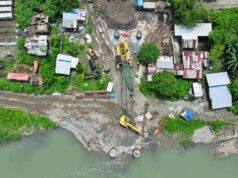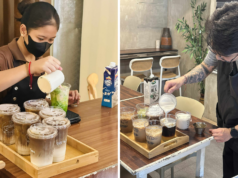CLARK FREEPORT – The chief of the Central Luzon police has admitted that crimes in his region has jacked up by 18.73 percent, citing statistics showing that murders and carnappings occur from 6 a.m. to 9 p.m., robbery from 12 midnight to 3 a.m., and theft from 3 p.m. to 6 p.m. in his region.
At a regional peace and order summit hosted Wednesday by Pampanga Gov. Lilia Pineda here, Central Luzon police director Chief Supt. Alan Purisima also noted that among the region’s seven provinces, the number of crimes in Bulacan was significantly higher than other provinces.
However, Purisima noted that Nueva Ecija is home to the biggest number of nine criminal groups, followed by Bulacan with four groups, Tarlac with three, Pampanga with two, and Bataan and Angeles City with one each.
Amid recent carnapping cases involving the Dominguez crime group, all seven governors of Central Luzon attended the summit where they signed a covenant vowing closer coordination and full use of their local resources to curb criminality in their region.
Also present during the summit were top regional and provincial police officials and directors of national government agencies in Central Luzon.
In his briefing, Purisima cited freshly tabulated crime statistics indicating that Bulacan, which is where the Dominguez carnapping syndicate is based, had the highest number of crimes in the region.
Bulacan had 20,083 various crimes on record, providing a wide gap from runner-up Nueva Ecija with 8,935 cases.
A total of 4,918 cases were noted in Pampanga, 4,397 in Bataan, 3,796 in Zambales, 1,944 in Aurora, 2,625 in Angeles City and 2,219 in Olongapo City. Tarlac was not cited in the report.
The total crimes reported in 2010 numbered 50,781, which is higher by 18.73 percent reported in 2009 when total crimes totaled 42,770.
However, latest census showed that in Central Luzon, Bulacan was the most populated with 2.8 million people, as against 1.8 million in Nueva Ecija. The census also showed 1.9 million population in Pampanga, .575 in Tarlac, .734 in Zambales, .371 in Bataan and about 98,000 in Aurora.
Purisima noted, however, that if the number of crimes in relation to population of each province is concerned, Aurora would be leading the list with 87 crimes per 100,000 people per month, followed by Bulacan with 50.34, Zambales with 45.4, Nueva Ecija with 36.70, Pampanga with 15.34, and Bataan with 6.41 per 100,000 population.
But Purisima stressed that the increase in crime rate in his region should be attributed to his policy for police field commanders to report truthfully. “When I assumed post, I found out that crime statistics did not reflect reality, so I told them to be truthful so that we could know the real situation and act accordingly,” he said.
He said that on a monthly average basis, an estimated 397 robberies, 769 thefts, 91 murders, 116 carnappings, 41 homicides, and 1,376 physical injuries occur in Central Luzon.
Purisima also noted statistics revealed that most of the robbery cases happened from 12 midnight to 3 a.m., theft from 3 p.m. to 6 p.m., and murder and carnapping from 6 p.m. to 9 p.m.
This, even as he bared various anti-crime schemes now being enforced in Central Luzon, such as the “No plate, no travel” policy for motorists and the fielding of 756 personnel in 111 checkpoints in the region.
He said that in Angeles City where the so-called Magtoto gang is engaged in prostitution and white slavery, closed circuit television cameras have been set up in strategic areas.
Purisima also said there are now more motorcycle zones where owners of motorcycles can park their bikes at malls and schools.
He urged local officials to pass ordinances for the establishment of “public safety zones” in their areas where motorists are required to go slow and roll down their vehicle’s windows or where those on motorcycles would be required not only to slow down but also remove their helmets.
At a regional peace and order summit hosted Wednesday by Pampanga Gov. Lilia Pineda here, Central Luzon police director Chief Supt. Alan Purisima also noted that among the region’s seven provinces, the number of crimes in Bulacan was significantly higher than other provinces.
However, Purisima noted that Nueva Ecija is home to the biggest number of nine criminal groups, followed by Bulacan with four groups, Tarlac with three, Pampanga with two, and Bataan and Angeles City with one each.
Amid recent carnapping cases involving the Dominguez crime group, all seven governors of Central Luzon attended the summit where they signed a covenant vowing closer coordination and full use of their local resources to curb criminality in their region.
Also present during the summit were top regional and provincial police officials and directors of national government agencies in Central Luzon.
In his briefing, Purisima cited freshly tabulated crime statistics indicating that Bulacan, which is where the Dominguez carnapping syndicate is based, had the highest number of crimes in the region.
Bulacan had 20,083 various crimes on record, providing a wide gap from runner-up Nueva Ecija with 8,935 cases.
A total of 4,918 cases were noted in Pampanga, 4,397 in Bataan, 3,796 in Zambales, 1,944 in Aurora, 2,625 in Angeles City and 2,219 in Olongapo City. Tarlac was not cited in the report.
The total crimes reported in 2010 numbered 50,781, which is higher by 18.73 percent reported in 2009 when total crimes totaled 42,770.
However, latest census showed that in Central Luzon, Bulacan was the most populated with 2.8 million people, as against 1.8 million in Nueva Ecija. The census also showed 1.9 million population in Pampanga, .575 in Tarlac, .734 in Zambales, .371 in Bataan and about 98,000 in Aurora.
Purisima noted, however, that if the number of crimes in relation to population of each province is concerned, Aurora would be leading the list with 87 crimes per 100,000 people per month, followed by Bulacan with 50.34, Zambales with 45.4, Nueva Ecija with 36.70, Pampanga with 15.34, and Bataan with 6.41 per 100,000 population.
But Purisima stressed that the increase in crime rate in his region should be attributed to his policy for police field commanders to report truthfully. “When I assumed post, I found out that crime statistics did not reflect reality, so I told them to be truthful so that we could know the real situation and act accordingly,” he said.
He said that on a monthly average basis, an estimated 397 robberies, 769 thefts, 91 murders, 116 carnappings, 41 homicides, and 1,376 physical injuries occur in Central Luzon.
Purisima also noted statistics revealed that most of the robbery cases happened from 12 midnight to 3 a.m., theft from 3 p.m. to 6 p.m., and murder and carnapping from 6 p.m. to 9 p.m.
This, even as he bared various anti-crime schemes now being enforced in Central Luzon, such as the “No plate, no travel” policy for motorists and the fielding of 756 personnel in 111 checkpoints in the region.
He said that in Angeles City where the so-called Magtoto gang is engaged in prostitution and white slavery, closed circuit television cameras have been set up in strategic areas.
Purisima also said there are now more motorcycle zones where owners of motorcycles can park their bikes at malls and schools.
He urged local officials to pass ordinances for the establishment of “public safety zones” in their areas where motorists are required to go slow and roll down their vehicle’s windows or where those on motorcycles would be required not only to slow down but also remove their helmets.



